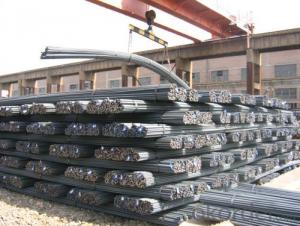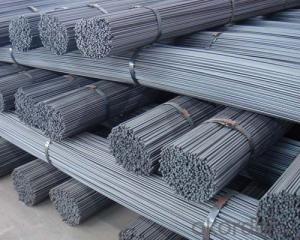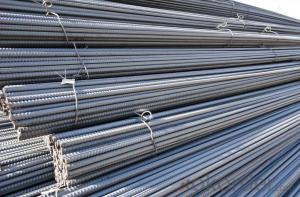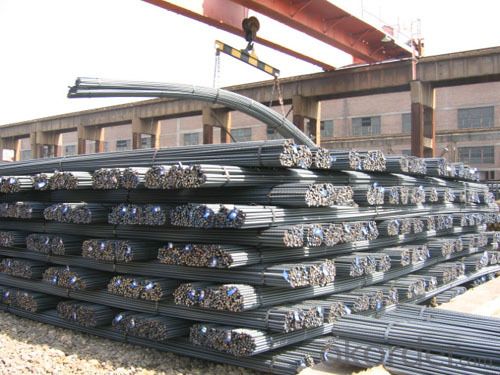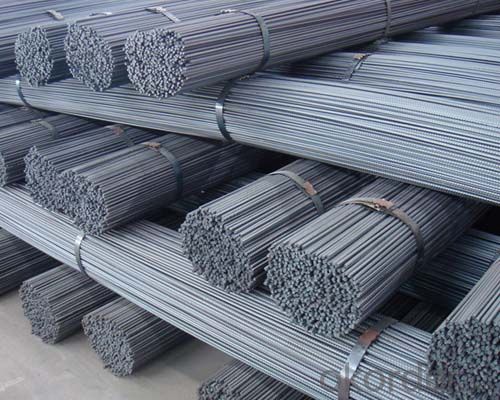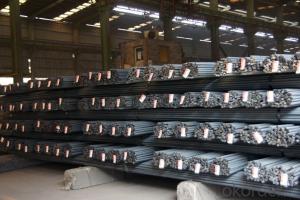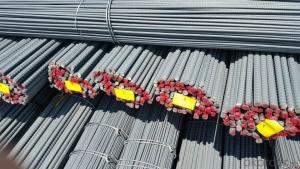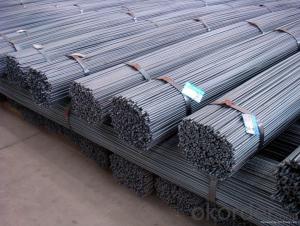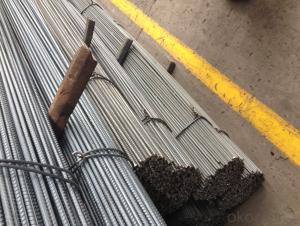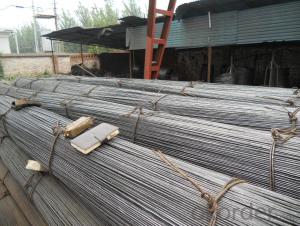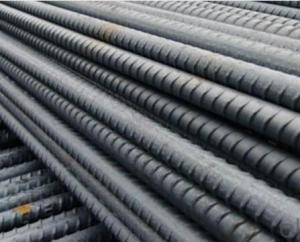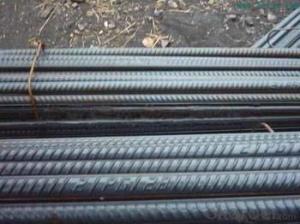Deformed bars in Grade HRB400/500 with Best Quality
- Loading Port:
- Tianjin
- Payment Terms:
- TT OR LC
- Min Order Qty:
- 25 m.t.
- Supply Capability:
- 100000 m.t./month
OKorder Service Pledge
OKorder Financial Service
You Might Also Like
Product Description:
Specifications of HRB400 Deformed Steel Bar:
Standard | GB | HRB400 | |
Diameter | 6mm,8mm,10mm,12mm,14mm,16mm,18mm,20mm, 22mm,25mm,28mm,32mm,36mm,40mm,50mm | ||
Length | 6M, 9M,12M or as required | ||
Place of origin | Hebei, China mainland | ||
Advantages | exact size, regular package, chemical and mechanical properties are stable. | ||
Type | Hot rolled deformed steel bar | ||
Brand name | DRAGON | ||
Chemical Composition: (Please kindly find our chemistry of our material based on HRB500 as below for your information)
Grade | Technical data of the original chemical composition (%) | ||||||
C | Mn | Si | S | P | V | ||
HRB400 | ≤0.25 | ≤1.60 | ≤0.80 | ≤0.045 | ≤0.045 | 0.04-0.12 | |
Physical capability | |||||||
Yield Strength (N/cm²) | Tensile Strength (N/cm²) | Elongation (%) | |||||
≥400 | ≥570 | ≥14 | |||||
Theoretical weight and section area of each diameter as below for your information:
Diameter(mm) | Section area (mm²) | Mass(kg/m) | Weight of 12m bar(kg) |
6 | 28.27 | 0.222 | 2.664 |
8 | 50.27 | 0.395 | 4.74 |
10 | 78.54 | 0.617 | 7.404 |
12 | 113.1 | 0.888 | 10.656 |
14 | 153.9 | 1.21 | 14.52 |
16 | 201.1 | 1.58 | 18.96 |
18 | 254.5 | 2.00 | 24 |
20 | 314.2 | 2.47 | 29.64 |
22 | 380.1 | 2.98 | 35.76 |
25 | 490.9 | 3.85 | 46.2 |
28 | 615.8 | 4.83 | 57.96 |
32 | 804.2 | 6.31 | 75.72 |
36 | 1018 | 7.99 | 98.88 |
40 | 1257 | 9.87 | 118.44 |
50 | 1964 | 15.42 | 185.04 |
Usage and Applications of HRB400 Deformed Steel Bar:
Deformed bar is widely used in buildings, bridges, roads and other engineering construction. Big to highways, railways, bridges, culverts, tunnels, public facilities such as flood control, dam, small to housing construction, beam, column, wall and the foundation of the plate, deformed bar is an integral structure material. With the development of world economy and the vigorous development of infrastructure construction, real estate, the demand for deformed bar will be larger and larger..
Packaging & Delivery of HRB400 Deformed Steel Bar:
Packaging Detail: products are packed in bundle and then shipped by container or bulk vessel, deformed bar is usually naked strapping delivery, when storing, please pay attention to moisture proof. The performance of rust will produce adverse effect.
Each bundle weight: 2-3MT, or as required
Payment term: TT or L/C
Delivery Detail: within 45 days after received advanced payment or LC.
Label: to be specified by customer, generally, each bundle has 1-2 labels
Trade terms: FOB, CFR, CIF
- Q: How do steel rebars affect the thermal conductivity of a structure?
- Steel rebars can significantly increase the thermal conductivity of a structure. Due to their high thermal conductivity, steel rebars act as conduits for heat transfer within the structure. This means that heat can easily flow from one part of the structure to another through the steel rebars, resulting in faster heat transmission and reduced thermal resistance. Consequently, the presence of steel rebars can enhance both the heat absorption and dissipation capacities of a structure, making it more susceptible to temperature changes and potentially affecting its overall thermal performance.
- Q: JL32 is the finish thread heavy bar 32? What's the difference between normal and ordinary? What does the front JL32 mean?
- Finishing rolling rebar strength than ordinary ribbed steel bars to be high, with spiral thread, tension nut after solid increase concrete prestressed (equivalent prestressed steel wire, steel wire type).
- Q: Are there any specific safety guidelines for working with steel rebars?
- Yes, there are specific safety guidelines for working with steel rebars. Some key guidelines include wearing appropriate personal protective equipment (PPE) such as gloves, safety glasses, and steel-toed boots. It is important to handle rebars with care to prevent injuries from sharp edges or protruding ends. Workers should also be cautious when cutting or bending rebars to avoid muscle strains or cuts. Additionally, it is essential to follow proper lifting techniques and ensure a safe working environment to minimize the risk of accidents.
- Q: What are the international standards for steel rebars?
- The international standards for steel rebars are defined by the International Organization for Standardization (ISO) and the American Society for Testing and Materials (ASTM). These standards encompass various factors such as the composition, mechanical properties, dimensions, and tolerances of steel rebars, ensuring their quality and performance in construction projects worldwide.
- Q: What are the different methods of reinforcing concrete with steel rebars?
- There are several methods for reinforcing concrete with steel rebars. The most common method is to place the rebars in a grid pattern throughout the concrete structure. This can be done by tying the rebars together with wire or using rebar chairs to hold them in place. Another method is to use precast concrete elements with embedded rebars that are then connected together. Additionally, steel mesh or fiber reinforcement can be used to reinforce the concrete. These methods all help to improve the strength and durability of the concrete structure.
- Q: What are the common grades of steel rebars?
- Steel rebars are commonly classified based on their yield strength, which measures the force needed to deform or bend the steel. The most frequently seen grades of steel rebars are Grade 40, Grade 60, and Grade 75. Grade 40 steel rebars possess a minimum yield strength of 40,000 pounds per square inch (psi) and are often utilized in general construction projects that require moderate strength. Grade 60 steel rebars have a minimum yield strength of 60,000 psi and are extensively employed in reinforced concrete structures like bridges, buildings, and highways. They exhibit superior strength and durability compared to Grade 40 rebars, making them suitable for heavy-duty applications. Grade 75 steel rebars have a minimum yield strength of 75,000 psi and are commonly used in high-rise buildings, dams, and other structures that demand exceptional strength and load-bearing capacity. These rebars provide the highest level of strength and are specifically designed for structures exposed to extreme conditions or heavy loads. It should be noted that the selection of the appropriate grade of steel rebars for a specific project is determined by structural engineers, considering factors such as expected loads, environmental conditions, and design specifications.
- Q: How are steel rebars used in the construction of oil and gas refineries?
- Steel rebars are widely used in the construction of oil and gas refineries due to their strength and durability. These rebars, which are made of high-strength steel, provide reinforcement to concrete structures and enhance their load-bearing capacity. In oil and gas refineries, steel rebars are primarily used in the construction of various reinforced concrete structures such as foundations, columns, beams, slabs, and walls. These structures are crucial for supporting heavy equipment, storage tanks, processing units, and other essential components of the refinery. Rebars are embedded within the concrete during the construction process, forming a reinforced concrete framework that can withstand high loads, seismic activity, and extreme weather conditions. The steel reinforcement enhances the tensile strength of the concrete, making it more resistant to cracking and structural failure. The use of rebars also ensures the longevity of the refinery infrastructure. Oil and gas refineries operate in harsh environments with exposure to chemicals, high temperatures, and corrosive agents. Steel rebars possess excellent resistance to corrosion, which is essential for maintaining the structural integrity of the refinery over time. Additionally, rebars facilitate the construction of complex shapes and configurations required in refinery structures. They can be bent, cut, and molded to fit specific design requirements, enabling the creation of intricate concrete structures that are essential for the refinery's functionality. Overall, steel rebars play a vital role in the construction of oil and gas refineries by providing the necessary reinforcement to concrete structures. Their strength, durability, and resistance to corrosion make them ideal for withstanding the demanding conditions found in these facilities, ensuring the safety and longevity of the refinery infrastructure.
- Q: How are steel rebars marked for identification?
- Steel rebars are typically marked for identification through a combination of embossed letters or numbers, paint markings, or colored plastic caps. These marking methods allow for easy identification and sorting of rebars based on their dimensions, grade, and manufacturer.
- Q: What are the different types of steel rebars available in the market?
- There are several types of steel rebars available in the market, including mild steel rebar, high-strength deformed steel rebar, epoxy-coated rebar, galvanized rebar, stainless steel rebar, and glass-fiber-reinforced polymer (GFRP) rebar. Each type has unique properties and is used for specific applications in construction and infrastructure projects.
- Q: Can steel rebars be bent or shaped on-site during construction?
- Yes, steel rebars can be bent or shaped on-site during construction. They are commonly bent using specialized tools such as rebar benders, which allow for precise bending and shaping according to the design requirements. This flexibility in on-site shaping makes steel rebars a versatile choice for reinforcing concrete structures.
Send your message to us
Deformed bars in Grade HRB400/500 with Best Quality
- Loading Port:
- Tianjin
- Payment Terms:
- TT OR LC
- Min Order Qty:
- 25 m.t.
- Supply Capability:
- 100000 m.t./month
OKorder Service Pledge
OKorder Financial Service
Similar products
Hot products
Hot Searches
Related keywords
